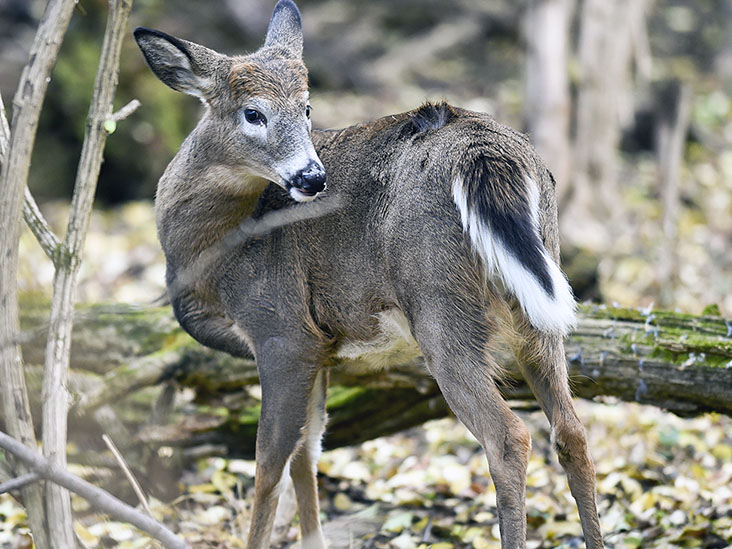
- SARS-CoV-2 originated in animals before being transmitted to humans.
- Animals are also able to acquire SARS-CoV-2 infections from humans.
- The present research documents that SARS-CoV-2 is spreading between white-tailed deer in the United States.
- This raises the possibility that a new variant of the virus could emerge from these deer and be a risk to humans.
A new study has found that white-tailed deer have acquired infection with SARS-CoV-2, which has then spread within deer populations.
The research, which appears in theProceedings of the National Academy of Sciences of the United States of America, raises the possibility of new variants of SARS-CoV-2 emerging in these deer populations. If a new variant were to emerge, it could potentially pose a risk to humans.
Zoonoses
SARS-CoV-2, the virus responsible for the COVID-19 pandemic, is a zoonotic disease. This means it first emerged in animals, although researchers are not sure precisely which species it originated.
Since causing infections in humans, SARS-CoV-2 has spread around the world — it affected not only humans but also other animal species.
Researchers have found evidence in experimental studies that ferrets, hamsters, cats, primates, bats, and mink can acquire SARS-CoV-2 infections. Nevertheless, naturally-occurring infection is rare in animals, with most reported domestic cases likely due to infection by close contact with individuals with COVID-19.
In the present research, the study authors have found evidence that SARS-CoV-2 is also present in free-living and captive white-tailed deer.
This is significant: if SARS-CoV-2 can exist in wild animal populations, such as deer, new variants could emerge within them.
If these new variants can spill back to humans, this could pose a risk — particularly if the variant is more infectious or causes severe illness.
Deer in Iowa
Medical News Today spoke with Dr. Suresh V. Kuchipudi, Dorothy Foehr Huck, and J. Lloyd Huck, Chair in Emerging Infectious Diseases at Penn State University, Pennsylvania. Dr. Kuchipudi is the corresponding author of the present study.
“We study emerging and zoonotic viruses and are particularly interested in virus spillover,” said Dr. Kuchipudi.
“Earlier studies showed the susceptibility of white-tailed deer to experimental SARS-CoV-2 infection and antibody evidence of SARS-CoV-2 disease in wild deer in multiple states of the U.S. Therefore, we did this study in collaboration with the Department of Natural Resources in Iowa to detect SARS-CoV-2 RNA in deer tissues, confirming the SARS-CoV-2 infection of deer in natural settings.”
Dr. Kuchipudi and his colleagues collected 283 retropharyngeal lymph node samples from deer in Iowa between April 2020 and January 2021 — 132 samples from captive deer and 151 from free-living deer.
Spillover and transmission
Ninety-two of these samples tested positive for SARS-CoV-2 RNA — just under a third of them.
Further, in the 7 weeks following the November 2020 peak of the pandemic, 80 of 97 (82.5%) samples tested positive.
The researchers looked at the types of variants found in the samples and cross-referenced these with known outbreaks of the variants in humans.
According to this information, the researchers believe that multiple transmissions from humans to deer were occurring and that deer were then transmitting the virus to other deer.
MNT spoke with Dr. Jürgen A. Richt, the Regents distinguished professor at Kansas State University in the College of Veterinary Medicine. Dr. Richt was not involved in the present study.
“Our team and others showed last year that white-tailed deer are highly susceptible to SARS-CoV-2 infection and readily transmit it to others after experimental infection.”
“The current research shows (i) that SARS-CoV-2 spilled over from humans to free-living deer in Iowa, and (ii) that using genomics and molecular epidemiological tools, the source of infection was likely multiple spillovers from humans followed by transmission amongst deer.”
“Both the extent of spillover and transmission of SARS-CoV-2 was unexpected and implies that there is a silent epidemic happening in white-tailed deer at the same time the virus is spreading in humans.”
– Dr. Richt
Potential risks
For Dr. Kuchipudi, this is a problem, as it means the deer could function as a reservoir for the virus, giving it space to mutate.
“Continued circulation of an RNA virus, such as SARS-CoV-2, in humans or nonanimal hosts could lead to novel variant emergence. It is possible that such novel variants could be more transmissible and potentially cause more severe diseases in humans and animals,” said Dr. Kuchipudi.
“In addition, novel variants emerging from an animal reservoir could escape the protection afforded by the current human COVID-19 vaccines.”
Dr. Richt agreed this was a possibility. However, he also cautioned that as yet, researchers could not know whether any potential variant would be more dangerous.
“While there remains a theoretical possibility that viral spread and potential adaptation in deer could generate either a more or less dangerous variant for humans, there is no evidence for or against this at this time.”
“What we do know — and this study and other studies, including our own, confirms this — is that the virus replicates at high levels in white-tailed deer and spreads quickly amongst them.”
“Since this is the case, viral evolution and adaptation is likely occurring in deer, but its impact and potential risk to human health is currently unknown,” said Dr. Richt.
Nonetheless, Dr. Kuchipudi argued that “[t]here is an urgent need for comprehensive surveillance of high risk animal species to monitor the virus evolution and better assess the transmission networks.”
Dr. Richt agreed.
“We and others have long called for establishing a robust surveillance system for monitoring emerging diseases in wildlife.”
“The current research highlights just how little we know about spillover risk from animals to humans and demonstrates the importance of developing and implementing nationally and even globally coordinated programs for the monitoring of emerging pathogens in wildlife.”
“Such a biosurveillance system would allow us to better understand the mechanisms of spillover from humans to deer,” argued Dr. Richt.
For live updates on the latest developments regarding the novel coronavirus and COVID-19, click here.
Source: Read Full Article
